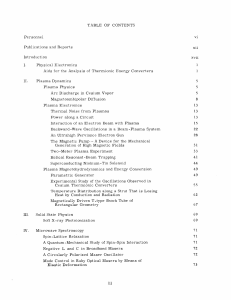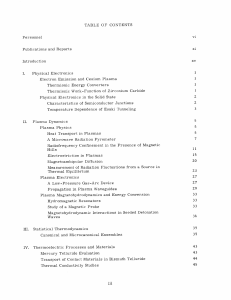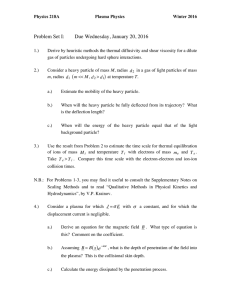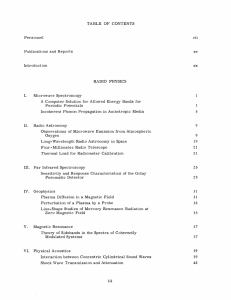NAME__________________________________ 6.651J,8.631J,22.611J R. Parker
advertisement
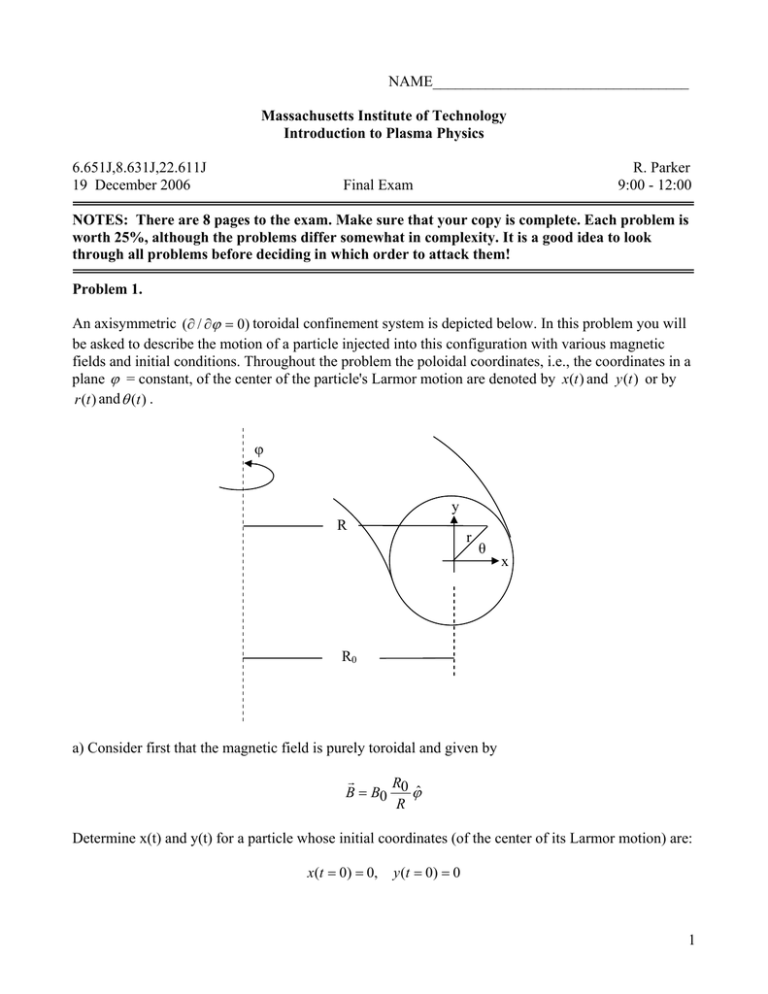
NAME__________________________________ Massachusetts Institute of Technology Introduction to Plasma Physics 6.651J,8.631J,22.611J 19 December 2006 R. Parker 9:00 - 12:00 Final Exam NOTES: There are 8 pages to the exam. Make sure that your copy is complete. Each problem is worth 25%, although the problems differ somewhat in complexity. It is a good idea to look through all problems before deciding in which order to attack them! Problem 1. An axisymmetric (∂ / ∂ϕ = 0) toroidal confinement system is depicted below. In this problem you will be asked to describe the motion of a particle injected into this configuration with various magnetic fields and initial conditions. Throughout the problem the poloidal coordinates, i.e., the coordinates in a plane ϕ = constant, of the center of the particle's Larmor motion are denoted by x(t ) and y (t ) or by r (t ) and θ (t ) . ϕ y R r θ x R0 a) Consider first that the magnetic field is purely toroidal and given by r R B = B0 0 ϕ̂ R Determine x(t) and y(t) for a particle whose initial coordinates (of the center of its Larmor motion) are: x(t = 0) = 0, y (t = 0 ) = 0 1 Problem 1. (Cont'd) 1 2 1 2 1 2 where the subscripts ⊥ and // refer to mv0 = mv⊥ 0 + mv// 0 2 2 2 perpendicular and parallel to the magnetic field, respectively. Denote the charge of the particle by q. and whose initial energy is b) Now assume that a weak poloidal field is added to the system, for example by adding a current in the ϕ-direction, so that the total magnetic field is r R r B = B0 0 ϕˆ + Bθ 0 θˆ R R v Neglect the drifts so that the particle follows field lines. What is the maximum value of ⊥ 0 for v0 which a particle starting at r = r0 , θ = 0 will orbit through an angle of 2π in the poloidal plane? r c) Consider now a particle having v⊥ = 0 , i.e., one with its velocity parallel to B . Neglecting drifts, the guiding center equations of motion in a poloidal plane of this particle are: dy = ωx , dt dx = −ωy . dt If the particle's guiding center is at r = r0 , θ = 0 at t = 0, what is ω ? What curve is traced out by the orbit in a poloidal plane? d) Assume now that the drift is "turned on" in part c) and assume further that the poloidal field is weak enough so that the particle's drift is well approximated by that due to the toroidal field acting alone. Continuing to assume that v⊥ = 0 , modify the differential equations in part c) to take into account this drift. e) Assume B02 >> Bθ20 so that ω ≈ constant. By solving the differential equations in part c), determine the orbit in the poloidal plane in the form f ( x, y ) = 0 , assuming the same initial conditions for its guiding center, namely r = r0 at t = 0. 2 Problem 2. In this problem you will be asked to estimate the thermal diffusivity of a plasma based on formulas for characteristic collision frequencies, velocities and lengths presented in the table below. Then, given the thermal conductivity, you will be asked to calculate the temperature distribution for a plasma heated by Ohmic (I2R) heating. . Quantity/Particles Electrons Protons Collision Frequency, ν Thermal Velocity, KT vt = m Larmor radius, thermal particle, ρ ve = 1.38 x10−15 n ( m −3 ) s −1 3 / 2 [Te (keV )] vte = 1.33x107 [Te (keV )]1 / 2 m / s 1/ 2 [T (keV )] ρe = 1.07 x10 − 4 e Resistivity parallel to B, η B(Tesla ) m vi = 2.5 x10−17 n ( m −3 ) s −1 3 / 2 [Ti (keV )] vti = 3.09 x105[Ti (keV )]1 / 2 m / s 1/ 2 [T (keV )] ρi = 4.57 x10−3 i B (Tesla ) m η = 2.5 x10−8[Te (keV )]−3 / 2 Ω m Note: ln Λ has been assumed to be 15. a) Using the values in the above table, estimate the thermal diffusivity χ ⊥ in a direction perpendicular to the magnetic field of a plasma with density n (ne = ni = n) , electron and ion temperatures r Te (keV ) and Ti (kev) and field B . b) Repeat part a) for the diffusivity χ // parallel to the magnetic field. (Continued on the next page) 3 Problem 2. (Cont'd) The figure below shows the cross-section of a slab of plasma of width 2l . The slab is infinite in extent in the x and z directions. The plasma density is n, there is a magnetic field B in the z-direction, and the plasma is heated by a current density J parallel to B .The ions and electrons can be assumed to be in equilibrium with temperature T. The density, field and current density are all spatially homogenous in the plasma. x r r B = zˆB, J = zˆJ y y = −l y=l c) The equation for plasma's thermal balance is r − ∇ ⋅ q + ηJ 2 = 0 r dkT dT (keV ) where the heat flux is given by q ( w / m 2 ) = − yˆ K ⊥ where α is a = − yˆα [T (keV )]−1 / 2 dy dy constant. Solve the thermal balance equation for T ( y ) in terms of α , l, J and η 0 where η 0 is the resistivity at T = 1 kev . Assume that T ( y ) is symmetric about x = 0 and T (l) = 0 . Hint: Recall the method of quadrature for solving a DE of the form multiplying the equation by f ( x) d dx f ( x) = g ( x) that begins by dy dy dx . dy 4 Problem 3. A high frequency electromagnetic wave is launched along the midplane of an Alcator C-Mod plasma, as sketched in Figure 3a on the page 7. The field along the midplane (in Tesla) is given by r B = ϕˆ 5 1 + r / 67 and the electron density along the midplane is given by ne (r ) = n0 (1 − (r / 20) 2 ) . The wave frequency is f = 210 GHz (2.1x1011 Hz) and throughout this problem it can be assumed that the transverse dimensions of the EM beam are small enough that it can be considered to propagate radially along the mid-plane of the plasma as a plane wave. Note ion motion is completely negligible at this frequency. The square of the index of refraction of the wave as a function of distance along the mid-plane radius is plotted in Figure 3b. As can be seen, at r = 20 cm, the index of refraction is 1, corresponding to free space, while at r = 12.5 cm the index of refraction is 0 and at r = 7.25 cm it is ± ∞ . a) Determine the central plasma density, n0 . b) Describe the plasma polarization at r = 12.5 cm, specifying whether it is linear, circular or elliptical, r and if circular or elliptical, what plane E is in and its direction of rotation. c) A model equation that can be used to describe the propagation of the wave is d 2E a + ( + b) E = 0 x dx 2 r where x is distance measured from the resonance and E is the vertical component of E . Determine values for the constants a and b. d) An analytic solution of the equation given in part iii) is available and can be used to calculate the reflection coefficient, Γ = 1 − exp( −π b Δ ) where Δ is the distance between the cutoff and resonance. Based on this result, comment on whether this represents a practical scheme for heating Alcator CMod plasmas. (See next page for helpful formulas) 5 Note: The dielectric tensor for a cold plasma in a spatially homogeneous magnetic field is: ⎡ K t ⎢ ⊥ K = ⎢− K X ⎢⎣ 0 KX 0 K⊥ 0 0 K // ⎤ ⎥ ⎥ ⎥⎦ where K⊥ = 1 + ω 2pi 2 −ω2 ωci + ω 2pe 2 −ω2 ωce ⎛ ω2 /ω 2 ⎜ pi ci ω pe / ωce − K X = iω ⎜ 2 −ω2 ω2 −ω2 ⎜ ωci ce ⎝ K // = 1 − ω 2pi ω2 − ω 2pe ω2 , ⎞ ⎟ ⎟, ⎟ ⎠ . r r The time-space dependence assume is ~ exp( −iωt + ik ⋅ r ) and the magnetic field is in the z-direction (which for this problem is the ϕ-direction.) r The dispersion relation for k = xˆk x + zˆk z is: k02 K ⊥ − k z2 − k02 K X k xk z k02 K X k xk z k02 K ⊥ − k 2 0 0 =0 k02 K // − k x2 6 ϕ r E r k r=0 r=20 cm Square of Index of Refraction Figure 3a. Setup for launching the wave Radial Distance from Center of Plasma (cm) Figure 3b. Index of refraction of the wave as a function of distance in the plasma. 7 Problem 4. In this problem, we consider the possibility that unstable waves could exist in a plasma in which the electrons are drifting through the ions. Specifically we model the electron and ion distribution functions as v 1 v 1 f e (v x ) = n0 e fi (v x ) = n0 i π (v − V ) 2 + v 2 π v2 + v2 x i x e where V is the electron drift velocity and n0 is the equilibrium density. (The ion charge is assumed to be e so that n0i = n0e = n0 .) Consider wave motion with the time-space dependence given by exp( −iωt + ikx ) . For simplicity assume that k is real, but that ω could be complex. a) Determine an algebraic dispersion relation relating ω and k. b) Repeat part a) using the quasi-neutrality approximation which is valid for low frequencies, namely, n1e + n1i = 0, where n1e and n1i are respectively the perturbed electron and ion densities. c) Solve the dispersion relation obtained in b) for ω ( k ) . d) Using the result from part c), for what values of the drift speed will the plasma waves be unstable? Possibly useful integrals: ∞ 1 π v ∫−∞ (vx2 +xve2 ) 2 vx − ς dvx = − 2ve ⎧ (ς − ive ) 2 ⎫ ⎨ 2 2 2 ⎬ Im ς > 0 ⎩ (ς + ve ) ⎭ ∞ 1 π ⎧ (ς + ive ) 2 ⎫ vx = − dv ∫ (v 2 + ve2 ) 2 vx − ς x 2ve ⎨⎩ (ς 2 + ve2 )2 ⎬⎭ Im ς < 0 −∞ x ∞ ∫ (v −∞ 2 x ⎧ ( v + iς ) ⎫ vx 1 dvx = π ⎨ 2e Im ς > 0 2 2 ⎬ + ve ) vx − ς ⎩ (ve + ς ) ⎭ 2 x ⎧ ( v − iς ) ⎫ vx 1 dvx = π ⎨ 2e Im ς < 0 2 2 ⎬ + ve ) vx − ς ⎩ (ve + ς ) ⎭ ∞ ∫ (v −∞ ∞ 1 π ⎧ (ς − ive ) 2 ⎫ vx2 = − dv ∫ (v 2 + ve2 ) 2 vx − ς x 2ve ς ⎨⎩ (ς 2 + ve2 ) 2 ⎬⎭ Im ς > 0 −∞ x ∞ 1 π ⎧ (ς + ive ) 2 ⎫ vx2 = − dv ∫ (v 2 + ve2 ) 2 vx − ς x 2ve ς ⎨⎩ (ς 2 + ve2 ) 2 ⎬⎭ Im ς < 0 −∞ x 8


